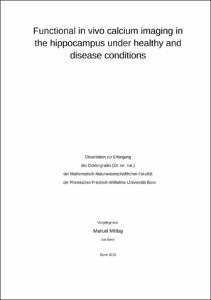Functional in vivo calcium imaging in the hippocampus under healthy and disease conditions

Functional in vivo calcium imaging in the hippocampus under healthy and disease conditions

| dc.contributor.advisor | Fuhrmann, Martin | |
| dc.contributor.author | Mittag, Manuel | |
| dc.date.accessioned | 2020-04-27T14:34:53Z | |
| dc.date.available | 2020-04-27T14:34:53Z | |
| dc.date.issued | 22.04.2020 | |
| dc.identifier.uri | https://hdl.handle.net/20.500.11811/8274 | |
| dc.description.abstract | The hippocampus has long been known to be essential for all features of memory processing. Hippocampal function strongly depends on the orchestrated activity of transiently autonomous neuronal populations that create the code for individual memory traces. Under disease conditions, dysfunction of the hippocampal network is associated with cognitive deficits. However, the mechanisms of network failure and how they relate to pathophysiological changes remain poorly understood. In this study, I addressed several molecular and cellular factors that can contribute to mechanisms leading to conditions of hippocampal network dysfunction. For this purpose, I utilized in vivo two-photon calcium (Ca2+) imaging in order to record neuronal activity in the CA1 region of the hippocampus. Ryanodine receptor (RyR) 2, the major isoform of RyR in the hippocampus, is an important mediator of intracellular Ca2+ signaling cascades. In this study, I reveal that hippocampus-specific knockout of Ryr2 in adult mice led to neuronal hyperactivity and impaired place cell firing. Considering further evidence from electrophysiological and morphological studies, the observed effect most probably can be related to cell shrinkage and alterations of intrinsic excitability due to dysregulation of long-term potentiation (LTP). The network dysfunction also translated to the behavioral level, where I observed impairments of spatial learning under hippocampus-specific Ryr2 knockout conditions. These evidences further support the theory, that RyR2 is in fact involved in mechanisms of synaptic plasticity not only in early developmental stages, but also in the adult brain. I established a chronic cranial window, allowing the recording of Ca2+ transients from hippocampal cornu ammonis (CA) 1 pyramidal neurons for the first time in rats. Similar to mice with hippocampus-specific knockout of Ryr2, I detected neuronal hyperactivity in CA1 pyramidal neurons at the pre-plaque stage in a rat model with Alzheimer’s disease (AD)-like pathology. In this sense, the rat model recapitulates previously described observations from mouse models with AD-like pathology. The increase in network activity was accompanied by morphological alterations as well as changes in the electrophysiological properties of the CA1 pyramidal neurons. Interestingly, no impairment of inhibitory function was observed, indicating that an overall increase in intrinsic excitability rather than disturbance of inhibition is the underlying cause for the network effect. The data of this thesis also demonstrates that impairment of inhibitory function can contribute to dysfunction of specific neuronal circuits. I showed that oriens-lacunosum moleculare (O-LM) inhibitory neurons in a mouse model with AD-like pathology exhibit a lack of cholinergic modulation, affecting information processing during associative-learning. Using two-photon in vivo Ca2+ imaging in different rodent models I could show that molecular factors like RyR2-mediated Ca2+ signaling but also cellular factors like activity of excitatory neurons as well as inhibitory neurons can contribute to hippocampal network function. Overall, the findings of this work will further help to understand the mechanisms underlying circuit and network function in the hippocampus. | en |
| dc.language.iso | eng | |
| dc.rights | In Copyright | |
| dc.rights.uri | http://rightsstatements.org/vocab/InC/1.0/ | |
| dc.subject | Neuroimmunologie | |
| dc.subject | Hippokampus | |
| dc.subject | Gedächtnis | |
| dc.subject | Lernen | |
| dc.subject | Navigation | |
| dc.subject | Alzheimer-Krankheit | |
| dc.subject | Kalzium | |
| dc.subject | Ryanodin-Rezeptor | |
| dc.subject | Signaltransduktion | |
| dc.subject | Ortszellen | |
| dc.subject | Multi-Photonen-Fluoreszenzmikroskopie | |
| dc.subject | Neuroimmulology | |
| dc.subject | Memory | |
| dc.subject | Learning | |
| dc.subject | Alzheimer's disease | |
| dc.subject | Calcium | |
| dc.subject | Ryanodine receptor | |
| dc.subject | Signal transduction | |
| dc.subject | Place cells | |
| dc.subject | Multi-photon-fluorescence-microscopy | |
| dc.subject.ddc | 570 Biowissenschaften, Biologie | |
| dc.subject.ddc | 610 Medizin, Gesundheit | |
| dc.title | Functional in vivo calcium imaging in the hippocampus under healthy and disease conditions | |
| dc.type | Dissertation oder Habilitation | |
| dc.publisher.name | Universitäts- und Landesbibliothek Bonn | |
| dc.publisher.location | Bonn | |
| dc.rights.accessRights | openAccess | |
| dc.identifier.urn | https://nbn-resolving.org/urn:nbn:de:hbz:5-57306 | |
| ulbbn.pubtype | Erstveröffentlichung | |
| ulbbnediss.affiliation.name | Rheinische Friedrich-Wilhelms-Universität Bonn | |
| ulbbnediss.affiliation.location | Bonn | |
| ulbbnediss.thesis.level | Dissertation | |
| ulbbnediss.dissID | 5730 | |
| ulbbnediss.date.accepted | 27.11.2019 | |
| ulbbnediss.institute | Angegliederte Institute, verbundene wissenschaftliche Einrichtungen : Deutsches Zentrum für Neurodegenerative Erkrankungen (DZNE) | |
| ulbbnediss.fakultaet | Mathematisch-Naturwissenschaftliche Fakultät | |
| dc.contributor.coReferee | Hofmann, Michael |
Dateien zu dieser Ressource
Das Dokument erscheint in:
-
E-Dissertationen (4397)




